Cary Town Council Tables Rezoning Second Time, Holds 3 Public Hearings
Cary, NC — The March 25, 2021 meeting of the Cary Town Council, while lasting nearly 3 hours, did not include any major votes.
Most decisions were tabled, deferred, or were forwarded on to the Planning and Zoning Board with the only approval of the night being the unanimous approval of the consent agenda. To look further into any of the 14 approved consent items, see the meeting’s online action agenda.
Honoring Cary Mayors — Past and Present
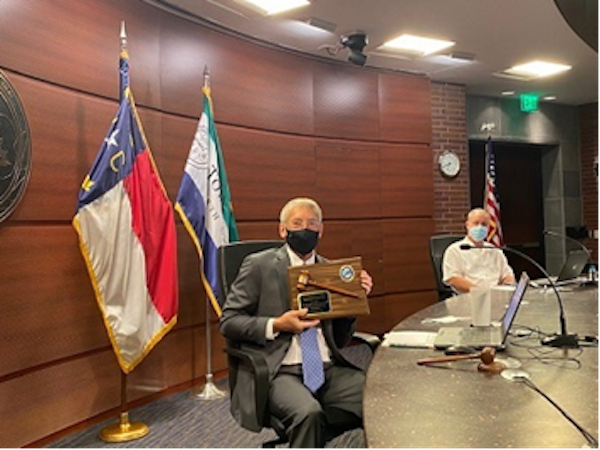
Councilmember Ed Yerha presented his third monthly history moment of 2021, this time on the topic of Cary’s 36 mayors over the past 150 years. The full 10-minute presentation can be viewed in this YouTube video.
What came as a bit of a surprise to Cary’s current mayor, Harold Weinbrecht Jr., was the presentation of a plaque and a moment of recognition for his 14 years spent in office since his initial election in 2007.
“This means he has served longer than any other mayor in Cary’s history—and counting,” said Yerha.
It’s a rare moment for Weinbrecht to be speechless in these council meetings, but this was one of them.
3 Public Hearings, No Decisive Votes
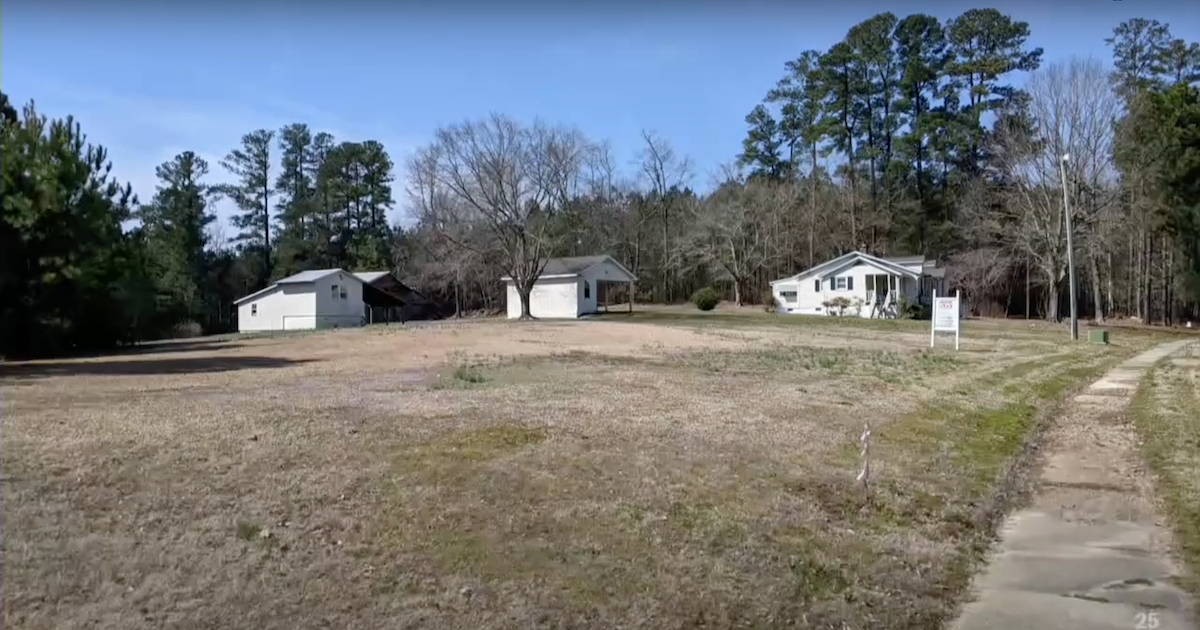
Photo shows the current condition of the 6.72-acre Lewey Drive site being considered for the construction of 40 townhomes.
Lewey Drive Rezoning (Case 20-REZ-08)
In this case, 6.72 acres of land located at 6705 Lewey Drive in West Cary, is being requested for annexation and rezoning with the intent to bring a maximum of 40 townhomes to the site.
Currently, the land has a Wake County zoning designation of Residential 40 Watershed (R-40W) and the applicant has requested the use to be Transitional Residential – Conditional Use (TR-CU) and Watershed Protection Overlay District (Jordan Lake Sub-district).
Zoning conditions in this case include:
- Limiting land use and density to a maximum of 40 townhouses
- Providing neighborhood recreation
- Providing a minimum of 2,400 square feet of community gathering space
- Providing drainage improvements
- Constructing a pedestrian connection to the sidewalk on the north side of Lewey Drive
- 60 amp wiring in all garages to accommodate electric vehicles
- Regrade and/or replace sidewalk along site frontage to improve drainage
- Reduce onsite runoff to existing stream channel by at least 25%
Following a presentation on the concerns related to stormwater and the reading of public hearing comments, the application was referred to Cary’s Planning and Zoning Board.
Five call-in speakers spoke in opposition to the request and 25 written comments also spoke against the rezoning, citing various reasons including density, traffic, intersection safety, environmental impacts and decreasing of surrounding property values.
Foster, Viersen, Miller, Clayton, White and Flythe Annexation (Case 19-A-20)
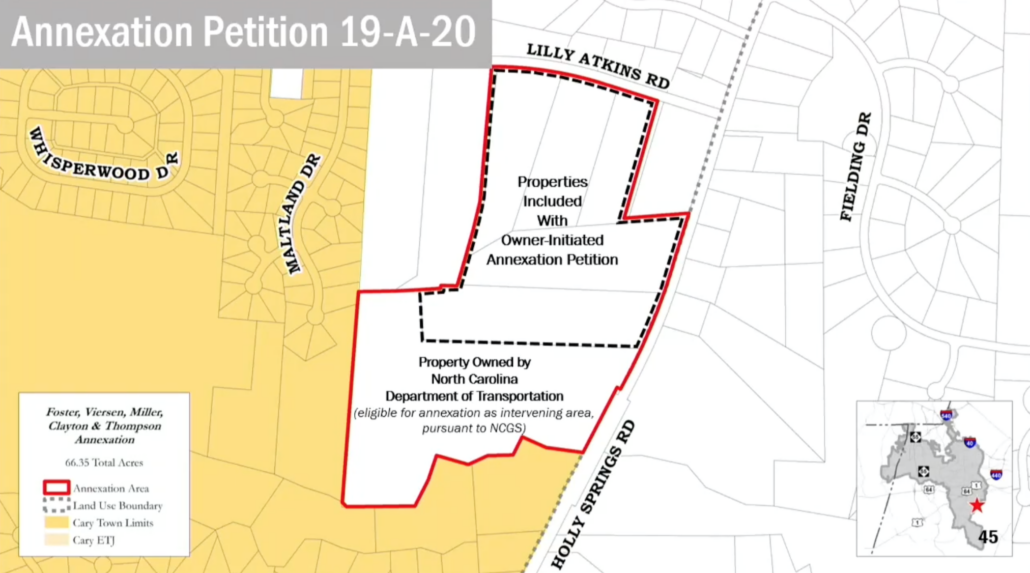
In the night’s second public hearing, the council considered an owner-initiated annexation petition for about 32 acres spanning across 5 parcels at Lily Atkins Road and Holly Springs Road. A portion of the total acreage is state-owed through the NCDOT.
In association with the annexation request, the property owner has submitted a rezoning case, 19-REZ-29, to apply initial Cary zoning to these properties. Specifically, the owner has proposed Transitional-Residential Conditional Use with conditions that limit use to age-restricted housing with a maximum density of 2 units per acre.
With no call-in speakers and no submitted comments, the public hearing closed. Following a brief discussion, the council deferred action on the request to a future meeting when the rezoning and annexation can be voted on together.
ACT 17 Town Code and LDO Amendments
In keeping current with the housekeeping of Cary’s legal codes, amendments have been proposed to Cary’s Town Code, Land Development Ordinance and Policy Statements. View more in-depth details on these amendments in these town documents and summaries.
Intending to achieve legal compliance with these amendments, the council held a public hearing in which no public comments were made on the proposed ACT 17 amendments. Now the amendments move to the Planning and Zoning Board for their review and recommendation.
Council Torn Over Carpenter Fire Station Rezoning Discussion, Again
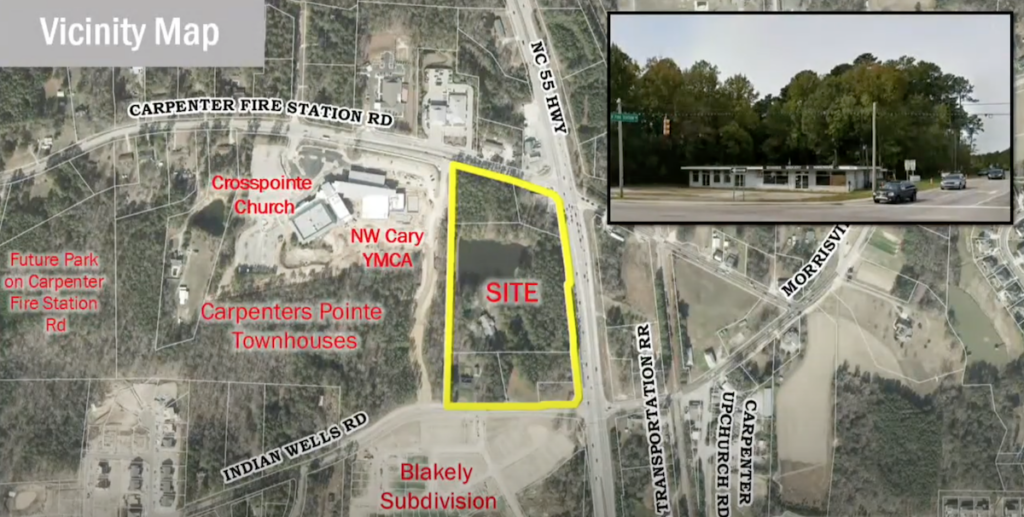
Carpenter Fire Station PDD Rezoning (Case 19-REZ-06)
Before going into a 45-minute closed session, the council revisited a rezoning case that had been tabled in the February 25, 2021 council meeting. Previously, the council cited intensity, parking reductions and concern of converting designated commercial/office space into more housing.
The site is approximately 14.6 acres, located at the southwest quadrant of the intersection of NC 55 Hwy and Carpenter Fire Station Road. The applicant seeks to change the zoning to allow for a maximum of 300 multi-family dwellings and between 5,000-10,000 square feet of office uses.
Going into the March 25 meeting, the Town of Cary’s P&Z board recommended consistency with the Cary Community Plan unanimously and Town planning staff also recommended approval with additional conditions proposed by the applicant.
According to the applicant’s legal representative, Jason Barron, who called in to the public speaks out portion of the meeting, these conditions include:
- 2 additional electric charging station (total 6)
- 10 more upper-story trees in the central open space (total of 60)
“I recognize those aren’t enforceable zoning conditions, but Wood Partners [the developer] will stand by their word in the event that the case is approved, they would move forward with the development plan that includes those items,” said Barron.
The first to speak up about the rezoning was councilwoman Jennifer Robinson.
“We’re being forced to vote on something that really isn’t right yet and I don’t really have total comfort with this development,” said Robinson.
In the February discussion, Robinson opposed the parking reductions and had some opposition to the masonry requirements as well. This time around she primarily cited discomfort with conditions being added too late in the game, so much so that they couldn’t be legally put into the rezoning agreement.
As she explained, rezoning conditions are intended to go with the land, not the applicant. So, if the land were to sell, (in theory) those conditions would have no legal footing to hold up with a different developer.
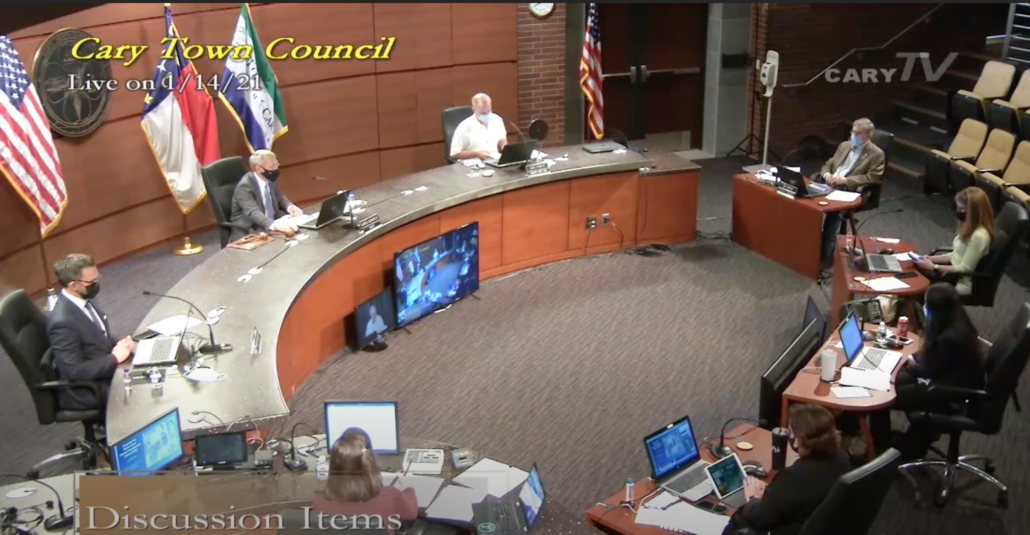
Also in the same boat as Robinson was Mayor Weinbrecht who pointed out that much of the conditions were only built on trust and not in writing, forcing his hand to not vote for approval.
The developer’s timeline restrictions posed another element of struggle for the council. On this, Mayor Pro-Tem Don Frantz expressed that he did not want to see the developer’s efforts have to restart again based on relatively small condition changes.
Councilmember Jack Smith also took opposition to the notion of a potential denial, saying
“To hold someone hostage that has worked in good faith with the staff that has held them to the highestest standards that we expect, I don’t know. For me, it feels disingenuous.”
Councilwoman Lori Bush, simply put, doesn’t hate it but doesn’t love the proposal either. Using the phrase, “wait for great,” she says it’s just not quite there yet and the addition of 2 charging stations and a few trees don’t address some of her larger concerns.
As the council got closer to a decision to table the item, Frantz tried to pinpoint what would need to be adjusted for the council to be on board. In response, the mayor said he would rather see a mix of housing and less density.
According to Town Manager Sean Stegall, the decision to unanimously table at this point in the development planning process was quite an anomaly. It has been at least 5 years since a development was not approved at this juncture after years of work with the Town.
Cary citizens can expect to see this request return to the table again at a future meeting, though the timeline is undetermined. To catch all commentary from the council on this and the other topics of the night, citizens can view the entire meeting on YouTube.
Story by Ashley Kairis. Images screen-captured from the live meeting.
All the Cary news for the informed Cary citizen. Subscribe by email.

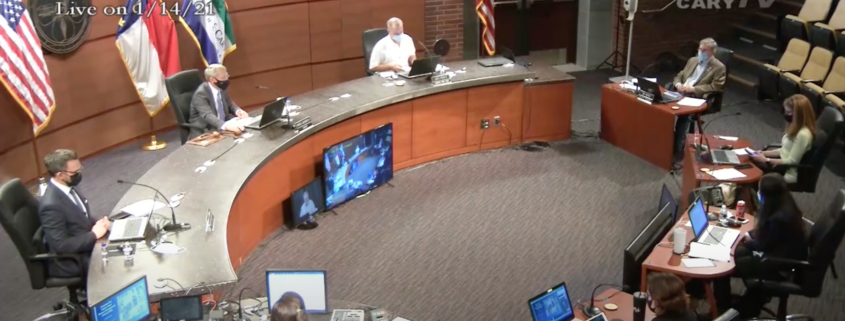


I’d like to see less townhomes and more single family homes. It seems like trees are being cut done and dense housing/buildings put up without regard to forestry. Tree buffers not only aesthetically look better when driving by but also environmentally benefit our communities. Please leave more than 1 row to give the trees
A chance.